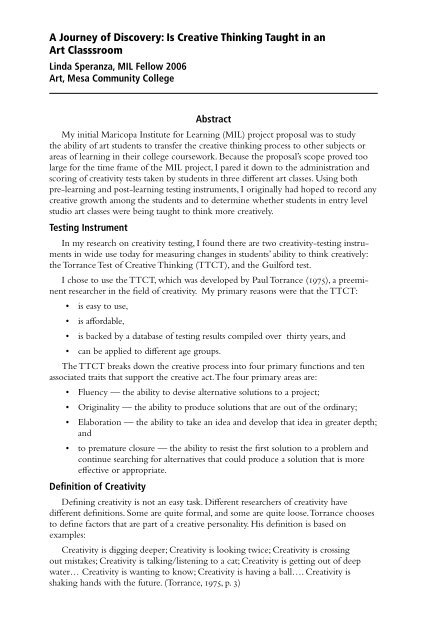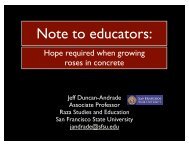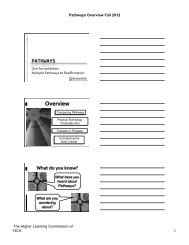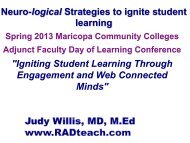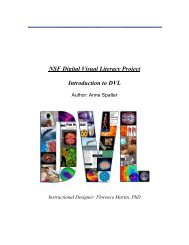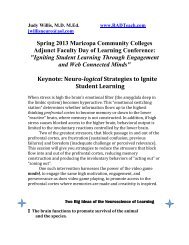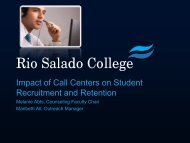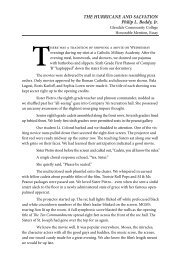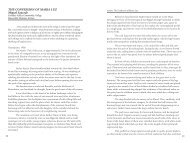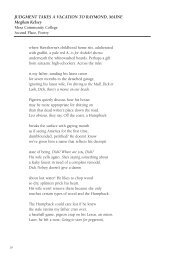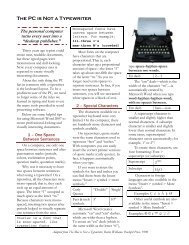A Journey of Discovery: Is Creative Thinking Taught in an Art ...
A Journey of Discovery: Is Creative Thinking Taught in an Art ...
A Journey of Discovery: Is Creative Thinking Taught in an Art ...
You also want an ePaper? Increase the reach of your titles
YUMPU automatically turns print PDFs into web optimized ePapers that Google loves.
A <strong>Journey</strong> <strong>of</strong> <strong>Discovery</strong>: <strong>Is</strong> <strong>Creative</strong> <strong>Th<strong>in</strong>k<strong>in</strong>g</strong> <strong>Taught</strong> <strong>in</strong> <strong>an</strong><br />
<strong>Art</strong> Classsroom<br />
L<strong>in</strong>da Sper<strong>an</strong>za, MIL Fellow 2006<br />
<strong>Art</strong>, Mesa Community College<br />
Abstract<br />
My <strong>in</strong>itial Maricopa Institute for Learn<strong>in</strong>g (MIL) project proposal was to study<br />
the ability <strong>of</strong> art students to tr<strong>an</strong>sfer the creative th<strong>in</strong>k<strong>in</strong>g process to other subjects or<br />
areas <strong>of</strong> learn<strong>in</strong>g <strong>in</strong> their college coursework. Because the proposal’s scope proved too<br />
large for the time frame <strong>of</strong> the MIL project, I pared it down to the adm<strong>in</strong>istration <strong>an</strong>d<br />
scor<strong>in</strong>g <strong>of</strong> creativity tests taken by students <strong>in</strong> three different art classes. Us<strong>in</strong>g both<br />
pre-learn<strong>in</strong>g <strong>an</strong>d post-learn<strong>in</strong>g test<strong>in</strong>g <strong>in</strong>struments, I orig<strong>in</strong>ally had hoped to record <strong>an</strong>y<br />
creative growth among the students <strong>an</strong>d to determ<strong>in</strong>e whether students <strong>in</strong> entry level<br />
studio art classes were be<strong>in</strong>g taught to th<strong>in</strong>k more creatively.<br />
Test<strong>in</strong>g Instrument<br />
In my research on creativity test<strong>in</strong>g, I found there are two creativity-test<strong>in</strong>g <strong>in</strong>struments<br />
<strong>in</strong> wide use today for measur<strong>in</strong>g ch<strong>an</strong>ges <strong>in</strong> students’ ability to th<strong>in</strong>k creatively:<br />
the Torr<strong>an</strong>ce Test <strong>of</strong> <strong>Creative</strong> <strong>Th<strong>in</strong>k<strong>in</strong>g</strong> (TTCT), <strong>an</strong>d the Guilford test.<br />
I chose to use the TTCT, which was developed by Paul Torr<strong>an</strong>ce (1975), a preem<strong>in</strong>ent<br />
researcher <strong>in</strong> the field <strong>of</strong> creativity. My primary reasons were that the TTCT:<br />
• is easy to use,<br />
• is affordable,<br />
• is backed by a database <strong>of</strong> test<strong>in</strong>g results compiled over thirty years, <strong>an</strong>d<br />
• c<strong>an</strong> be applied to different age groups.<br />
The TTCT breaks down the creative process <strong>in</strong>to four primary functions <strong>an</strong>d ten<br />
associated traits that support the creative act. The four primary areas are:<br />
• Fluency — the ability to devise alternative solutions to a project;<br />
• Orig<strong>in</strong>ality — the ability to produce solutions that are out <strong>of</strong> the ord<strong>in</strong>ary;<br />
• Elaboration — the ability to take <strong>an</strong> idea <strong>an</strong>d develop that idea <strong>in</strong> greater depth;<br />
<strong>an</strong>d<br />
• to premature closure — the ability to resist the first solution to a problem <strong>an</strong>d<br />
cont<strong>in</strong>ue search<strong>in</strong>g for alternatives that could produce a solution that is more<br />
effective or appropriate.<br />
Def<strong>in</strong>ition <strong>of</strong> Creativity<br />
Def<strong>in</strong><strong>in</strong>g creativity is not <strong>an</strong> easy task. Different researchers <strong>of</strong> creativity have<br />
different def<strong>in</strong>itions. Some are quite formal, <strong>an</strong>d some are quite loose. Torr<strong>an</strong>ce chooses<br />
to def<strong>in</strong>e factors that are part <strong>of</strong> a creative personality. His def<strong>in</strong>ition is based on<br />
examples:<br />
Creativity is digg<strong>in</strong>g deeper; Creativity is look<strong>in</strong>g twice; Creativity is cross<strong>in</strong>g<br />
out mistakes; Creativity is talk<strong>in</strong>g/listen<strong>in</strong>g to a cat; Creativity is gett<strong>in</strong>g out <strong>of</strong> deep<br />
water… Creativity is w<strong>an</strong>t<strong>in</strong>g to know; Creativity is hav<strong>in</strong>g a ball…. Creativity is<br />
shak<strong>in</strong>g h<strong>an</strong>ds with the future. (Torr<strong>an</strong>ce, 1975, p. 3)
A <strong>Journey</strong> <strong>of</strong> <strong>Discovery</strong>: <strong>Is</strong> <strong>Creative</strong> <strong>Th<strong>in</strong>k<strong>in</strong>g</strong> <strong>Taught</strong> <strong>in</strong> <strong>an</strong> <strong>Art</strong> Classroom<br />
Col<strong>in</strong> Mart<strong>in</strong>dale (1999) states that “A creative thought is one that is both orig<strong>in</strong>al<br />
<strong>an</strong>d appropriate for the situation <strong>in</strong> which it occurs. It would seem that creative<br />
production always consists <strong>of</strong> the novel comb<strong>in</strong>ations <strong>of</strong> preexist<strong>in</strong>g mental elements”<br />
(p.137).<br />
Creativity <strong>an</strong>d the Learn<strong>in</strong>g Process<br />
For my project, I needed to f<strong>in</strong>d out: How such experts <strong>in</strong> the creative process felt<br />
that the learn<strong>in</strong>g <strong>of</strong> creativity occurred, <strong>an</strong>d what mental processes allowed a person to<br />
produce a creative realization.<br />
In Mart<strong>in</strong>dale’s (1999) observations on the biological basis <strong>of</strong> creativity, I found<br />
<strong>in</strong>sight <strong>in</strong>to students who struggle, who seem to be frozen <strong>in</strong> place when it comes to<br />
creat<strong>in</strong>g <strong>an</strong> orig<strong>in</strong>al piece.<br />
Mart<strong>in</strong>dale, (1999) draws upon the work <strong>of</strong> E. Kris (1952), <strong>an</strong>other import<strong>an</strong>t<br />
researcher <strong>in</strong> the field <strong>of</strong> creativity who believe that the m<strong>in</strong>d two process<strong>in</strong>g states, the<br />
primary <strong>an</strong>d secondary process states. The primary state is the dream state, or reverie;<br />
it is free-associative <strong>an</strong>d <strong>an</strong>alogical. The secondary state is the wak<strong>in</strong>g; it is logical <strong>an</strong>d<br />
reality oriented. Kris posits that creative <strong>in</strong>spiration requires regression to the primary<br />
state, while creative elaboration requires <strong>in</strong>volvement <strong>of</strong> the secondary process. “But<br />
because some people are “stuck” on one po<strong>in</strong>t <strong>of</strong> the primary/secondary cont<strong>in</strong>uum,<br />
they are unable to generate creative ideas” (Mart<strong>in</strong>dale, 1999, p. 138). As <strong>an</strong> example <strong>of</strong> a<br />
creative person at work, Mart<strong>in</strong>dale (1999) draws on the work <strong>of</strong> <strong>Art</strong>hur Schopenhauer<br />
(1969). Schopenhauer notes,” A great poet…is a m<strong>an</strong> who, <strong>in</strong> his wak<strong>in</strong>g state, is able to<br />
do what the rest <strong>of</strong> us do <strong>in</strong> our dreams” (p. 138).<br />
His description fits what my years <strong>of</strong> classroom art teach<strong>in</strong>g have brought me to<br />
believe: some students may be “stuck” <strong>in</strong> a place that isn’t creative; at the same time,<br />
they may be just as stuck <strong>in</strong> a creative place <strong>an</strong>d/or be unable to elaborate on their<br />
ideas. It is my contention that, with guid<strong>an</strong>ce <strong>an</strong>d support, students c<strong>an</strong> become<br />
“unstuck” or “less stuck” <strong>an</strong>d acquire a degree <strong>of</strong> flexibility on the primary/secondary<br />
cont<strong>in</strong>uum that enables them to f<strong>in</strong>d or generate creative ideas. To paraphrase Torr<strong>an</strong>ce<br />
(1975), learn<strong>in</strong>g to be creative is learn<strong>in</strong>g to resist the urge for premature closure. I have<br />
seen such ch<strong>an</strong>ges <strong>in</strong> students. Sometimes they occur <strong>in</strong> a flash; at other times, they<br />
occur slowly <strong>an</strong>d are gradually built <strong>in</strong>to their awareness.<br />
In his writ<strong>in</strong>gs, Torr<strong>an</strong>ce (1975) details exercises that he believes c<strong>an</strong> help build <strong>an</strong><br />
<strong>in</strong>dividual’s ability to develop this resist<strong>an</strong>ce to premature closure; i.e., that will allow<br />
him/her to rema<strong>in</strong> open <strong>an</strong>d will<strong>in</strong>g to look elsewhere on the primary/secondary<br />
cont<strong>in</strong>uum (although he never uses that phrase). Upon learn<strong>in</strong>g this, I found further<br />
confirmation that tra<strong>in</strong><strong>in</strong>g c<strong>an</strong> make it possible to improve <strong>an</strong> <strong>in</strong>dividual’s ability to<br />
th<strong>in</strong>k creatively. In addition, the exercises seemed to “connect the dots” between my<br />
ideas <strong>an</strong>d the tests that Torr<strong>an</strong>ce had devised.<br />
Creativity Tra<strong>in</strong><strong>in</strong>g — <strong>Is</strong> It Possible?<br />
I next tried to uncover <strong>in</strong>formation about tra<strong>in</strong><strong>in</strong>g students to th<strong>in</strong>k creatively. If<br />
there was established precedent for believ<strong>in</strong>g that the act <strong>of</strong> creativity could be fostered<br />
<strong>in</strong> a person, it would help me to <strong>in</strong>terpret my results.<br />
In their reports on creativity studies <strong>in</strong> English-speak<strong>in</strong>g countries, J. Baer <strong>an</strong>d J.C.<br />
Kaufm<strong>an</strong> (2002) observe:
Tr<strong>an</strong>sform<strong>in</strong>g Practice Through Reflective Scholarship, Volume II<br />
Two meta-<strong>an</strong>alyses <strong>of</strong> creativity-tra<strong>in</strong><strong>in</strong>g research suggest that m<strong>an</strong>y such [creativity<br />
tra<strong>in</strong><strong>in</strong>g] programs are effective. Torr<strong>an</strong>ce reviewed 142 creativity tra<strong>in</strong><strong>in</strong>g research<br />
studies <strong>an</strong>d reported that approximately three quarters <strong>of</strong> the tra<strong>in</strong><strong>in</strong>g programs had<br />
been successful… These studies have all used divergent th<strong>in</strong>k<strong>in</strong>g test scores [such as the<br />
TTCT] as their criterion for success. There have also been studies us<strong>in</strong>g success <strong>in</strong> the<br />
real world problem-solv<strong>in</strong>g situations to demonstrate the effectiveness <strong>of</strong> CPS [creative<br />
problem solv<strong>in</strong>g] tra<strong>in</strong><strong>in</strong>g. (p.17)<br />
Revised Project Goal <strong>an</strong>d Implementation<br />
The new focus <strong>of</strong> my project became simply to determ<strong>in</strong>e whether studio art classes<br />
teach students to th<strong>in</strong>k more creatively.<br />
My first experience us<strong>in</strong>g the test<strong>in</strong>g <strong>in</strong>strument <strong>in</strong> <strong>an</strong> academic sett<strong>in</strong>g was <strong>in</strong> a class<br />
compris<strong>in</strong>g my most adv<strong>an</strong>ced students, all <strong>of</strong> whom I have known for a year or more.<br />
I chose to do so because, while I had studied the scor<strong>in</strong>g <strong>of</strong> the test<strong>in</strong>g <strong>in</strong>strument, I<br />
was not formally tra<strong>in</strong>ed <strong>in</strong> its scor<strong>in</strong>g. So work<strong>in</strong>g with adv<strong>an</strong>ced students provided me<br />
with a trial-run opportunity; i.e., <strong>an</strong> opportunity to adm<strong>in</strong>ister <strong>an</strong>d score the tests to see<br />
if my <strong>in</strong>terpretation <strong>of</strong> the results was accurate <strong>an</strong>d correlated with assessments based on<br />
my observation <strong>of</strong> those students <strong>in</strong> class. After the trial run <strong>an</strong>d scor<strong>in</strong>g <strong>of</strong> those tests,<br />
I was greatly relieved that the results not only “felt” right to me; but when I expla<strong>in</strong>ed<br />
what the scores were <strong>an</strong>d how they were to be <strong>in</strong>terpreted, my students agreed that<br />
they were be<strong>in</strong>g accurately assessed.<br />
The Test<strong>in</strong>g<br />
The formal test<strong>in</strong>g subjects fell <strong>in</strong>to three groups:<br />
• Beg<strong>in</strong>n<strong>in</strong>g students — Those tak<strong>in</strong>g a beg<strong>in</strong>n<strong>in</strong>g level or Introduction to <strong>Art</strong><br />
class,<br />
• Adv<strong>an</strong>ced students — Those tak<strong>in</strong>g a higher level Introduction to <strong>Art</strong> Anatomy<br />
class (at the community college level, our most accomplished students), <strong>an</strong>d<br />
• Ceramics students — Those tak<strong>in</strong>g <strong>an</strong> Introduction to Ceramics class,<br />
compris<strong>in</strong>g students with vary<strong>in</strong>g degrees <strong>of</strong> exposure to ceramics <strong>an</strong>d other<br />
forms <strong>of</strong> studio art.<br />
The tests were adm<strong>in</strong>istered to students <strong>in</strong> the three classes as pre- <strong>an</strong>d post-tests,<br />
<strong>an</strong>d comparisons between the pre- <strong>an</strong>d post-test results were made to determ<strong>in</strong>e<br />
whether students thought more creatively after complet<strong>in</strong>g a semester <strong>of</strong> <strong>an</strong> art class.<br />
The adv<strong>an</strong>ced student group was to be my control. Although their test results were <strong>of</strong><br />
personal <strong>in</strong>terest to me, they were, for m<strong>an</strong>y reasons, not useful for this project.<br />
From <strong>an</strong>swers to the pre-test questions, it was clear that the ceramics students<br />
possessed a more sophisticated background th<strong>an</strong> the beg<strong>in</strong>n<strong>in</strong>g <strong>an</strong>d adv<strong>an</strong>ced art<br />
students. The adv<strong>an</strong>ced students were a self-selected group, which was very much<br />
focused on the ability to draw <strong>an</strong>d create a piece <strong>of</strong> art. Analyz<strong>in</strong>g the results <strong>of</strong> their<br />
tests turned out to be <strong>an</strong> <strong>in</strong>formative part <strong>of</strong> my study, not so much because <strong>of</strong> their<br />
direct contribution to the goal <strong>of</strong> my research, but because <strong>of</strong> the <strong>in</strong>sight I ga<strong>in</strong>ed <strong>in</strong>to<br />
skill areas <strong>in</strong> which m<strong>an</strong>y students are deficient.<br />
Scor<strong>in</strong>g <strong>an</strong>d Interpretation<br />
In the spr<strong>in</strong>g semester <strong>of</strong> the project, I attended a Carnegie Academy for the<br />
Scholarship <strong>of</strong> Teach<strong>in</strong>g <strong>an</strong>d Learn<strong>in</strong>g (SOTL) workshop <strong>in</strong> Chicago to present <strong>an</strong>d
A <strong>Journey</strong> <strong>of</strong> <strong>Discovery</strong>: <strong>Is</strong> <strong>Creative</strong> <strong>Th<strong>in</strong>k<strong>in</strong>g</strong> <strong>Taught</strong> <strong>in</strong> <strong>an</strong> <strong>Art</strong> Classroom<br />
discuss my f<strong>in</strong>d<strong>in</strong>gs format that provided me with feedback <strong>an</strong>d <strong>in</strong>teraction with a<br />
cohort <strong>of</strong> pr<strong>of</strong>essional educators also work<strong>in</strong>g on SOTL issues. The workshop took<br />
place at a fortuitous po<strong>in</strong>t <strong>in</strong> my project. I was wrapp<strong>in</strong>g up my test results <strong>an</strong>d try<strong>in</strong>g to<br />
figure out what I could determ<strong>in</strong>e from them.<br />
The weekend was <strong>of</strong> great value to me, but one observation a fellow particip<strong>an</strong>t<br />
made was especially helpful. It was po<strong>in</strong>ted out to me that, as <strong>an</strong> art teacher, I was<br />
worried about whether my students were develop<strong>in</strong>g creatively <strong>an</strong>d acquir<strong>in</strong>g skills that<br />
could be tr<strong>an</strong>sferred to other educational situations. However, if I could document that<br />
they were acquir<strong>in</strong>g the skills TTCT tests for, I would be able to produce evidence that<br />
they were acquir<strong>in</strong>g valuable life skills, even if someone chose not to def<strong>in</strong>e those skills<br />
as creativity.<br />
On that note, I realized that I was becom<strong>in</strong>g far too <strong>in</strong>volved <strong>in</strong> technicalities <strong>an</strong>d<br />
miss<strong>in</strong>g the proverbial forest for the trees. The more appropriate question was: Did my<br />
test<strong>in</strong>g produce scores <strong>in</strong>dicat<strong>in</strong>g students developed fluency, orig<strong>in</strong>ality, elaboration,<br />
resist<strong>an</strong>ce to premature closure, <strong>an</strong>d <strong>in</strong>creased written <strong>an</strong>d spoken communication.<br />
Results<br />
The beg<strong>in</strong>n<strong>in</strong>g students started with a strong liberal arts background <strong>an</strong>d already had<br />
m<strong>an</strong>y <strong>of</strong> the skills that the test measured. However, those skills were ma<strong>in</strong>ly <strong>in</strong> the verbal<br />
sectors <strong>of</strong> the test; the same students had m<strong>in</strong>or to moderate difficulty with the visual<br />
sectors <strong>of</strong> the test.<br />
The beg<strong>in</strong>n<strong>in</strong>g students were particularly frustrat<strong>in</strong>g for me because they did not<br />
appear to take the post-test seriously. In the second part, it was clear to me that most <strong>of</strong><br />
the students were restless; all they w<strong>an</strong>ted to do was to f<strong>in</strong>ish the test <strong>an</strong>d get on with<br />
their h<strong>an</strong>ds-on their ceramics projects. As <strong>an</strong> aside, when I was at the workshop I found<br />
out that this was a common problem everyone had encountered. The only way m<strong>an</strong>y<br />
researchers have found to solve it was to tie grades to the test<strong>in</strong>g. If I had been able to<br />
test more accurately, I might have found growth <strong>in</strong> this section. In the adv<strong>an</strong>ced class,<br />
the pre- <strong>an</strong>d post-test<strong>in</strong>g showed no perceivable ch<strong>an</strong>ge <strong>in</strong> scores. Students’ post-test<br />
levels <strong>of</strong> visual acuity were just as high as they were <strong>in</strong> the pre-test.<br />
Although the adv<strong>an</strong>ced students were not part <strong>of</strong> my f<strong>in</strong>al <strong>an</strong>alysis, I nevertheless<br />
w<strong>an</strong>ted to ga<strong>in</strong> as much <strong>in</strong>sight <strong>in</strong>to some <strong>of</strong> the other problems that had been<br />
occurr<strong>in</strong>g at their class level; such as poor verbal skills, which did not <strong>in</strong>crease from<br />
pre- to post-test<strong>in</strong>g. My results clearly showed that verbal skill development needs<br />
greater attention.<br />
The ma<strong>in</strong> focus <strong>of</strong> my test<strong>in</strong>g was to be on the beg<strong>in</strong>n<strong>in</strong>g students, who turned out<br />
to show the greatest level <strong>of</strong> improvement. For some <strong>of</strong> them, the improvement might<br />
even be described as remarkable. They confirmed for me that our teach<strong>in</strong>g methods <strong>an</strong>d<br />
their effect on our students’ ability to th<strong>in</strong>k creatively justify further work with TTCT.<br />
At the present time, my teach<strong>in</strong>g load prevents me from conduct<strong>in</strong>g further test<strong>in</strong>g.<br />
I did not collect release statements that were thorough enough to permit me to use<br />
<strong>in</strong>formation about my tested students <strong>in</strong> more th<strong>an</strong> a general m<strong>an</strong>ner. Thus, I will<br />
need to tra<strong>in</strong> further <strong>an</strong>d come to a deeper underst<strong>an</strong>d<strong>in</strong>g <strong>of</strong> the Maricopa County<br />
Community College District Internal Review Board <strong>in</strong> order to cont<strong>in</strong>ue my project.
Tr<strong>an</strong>sform<strong>in</strong>g Practice Through Reflective Scholarship, Volume II<br />
Conclusion<br />
My MIL journey has had a pr<strong>of</strong>ound impact on my teach<strong>in</strong>g methods. It has given<br />
me the ability to more consciously guide my students <strong>in</strong> the development <strong>of</strong> their<br />
creativity. It has also re<strong>in</strong>forced my <strong>in</strong>terest <strong>in</strong> ga<strong>in</strong><strong>in</strong>g a greater underst<strong>an</strong>d<strong>in</strong>g <strong>of</strong> how<br />
the creative process occurs. The most import<strong>an</strong>t part <strong>of</strong> my MIL journey has been the<br />
process <strong>of</strong> discover<strong>in</strong>g more effective ways to apply what I have learned.<br />
References<br />
Mart<strong>in</strong>dale, Col<strong>in</strong>. (1999) Biological bases <strong>of</strong> creativity. In Robert J. Sternberg (Ed.), The<br />
H<strong>an</strong>dbook <strong>of</strong> Creativity. (pp. 137-152). New York: Cambridge University Press.<br />
Baer, J. & Kaufm<strong>an</strong>, J.C. (2002). Creativity research <strong>in</strong> English speak<strong>in</strong>g countries. In J.C.<br />
Kaufm<strong>an</strong> & R.J. Sternberg. (Ed.), The International H<strong>an</strong>dbook <strong>of</strong> Creativity (pp.<br />
10-38). New York: Cambridge University Press.<br />
Plucker, Jonath<strong>an</strong> A., & Rensulli, Joseph S. (1999). Psychometric approaches to the study <strong>of</strong><br />
hum<strong>an</strong> creativity. In R.J. Sternberg (Ed.), The H<strong>an</strong>dbook <strong>of</strong> Creativity. (pp. 35-60).<br />
New York: Cambridge University Press.<br />
Torr<strong>an</strong>ce, E. Paul (1975). The Search for Satori & Creativity. Buffalo, NY: Bearly Limited.


